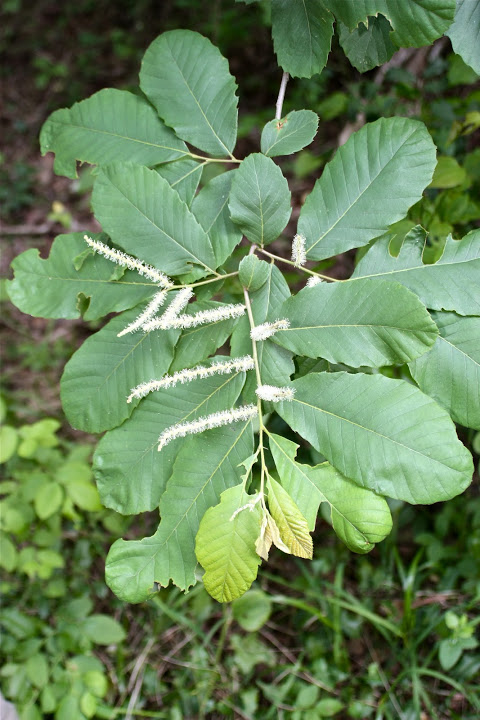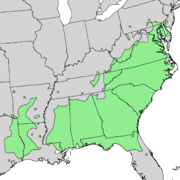Chinquapin
Castanea pumila (L.) Mill.
Description
Also known as Allegheny chinquapin, American chinquapin, Allegheny chinkapin² or dwarf chestnut, chinquapin is a member of the beech family (Fagaceae) ¹. It can be a multi-stemmed shrub or small tree reaching heights of 30 feet¹ or even 65 feet 4. it has smooth bark³. The alternative leaves are 3 to 5 inches long and 1.5 to 2 inches wide with sharply serrated margins¹. The leaves are yellow green on the upper surface and silver beneath with numerous hairs¹. Male and female flowers are on the same plant (monoecious) with the male flowers in catkins up to 5 inches long the leaf axils. Female flowers flowers produce a round, spine-covered bur containing a single nut³. The shiny brown nuts are about one inch in diameter and sweet and edible³.

Male flowers of chinquapin. @ J. Brighton* 2012, Maryland Biodiversity Project 5

Fruit of chinquapin. @ M. Beziat* 2018, Maryland Biodiversity Project 5

Nut of chinquapin. @ J. Brighton* 2014, Maryland Biodiversity Project 5
Distribution
Chinquapin is distributed from southern New Jersey and Pennsylvania south and west to eastern Texas 4. It grows in dry, well drained soils with full to partial sunlight¹. In Maryland it is found largely on the Chesapeake Western Shore and Piedmont and in Allegheny County 5.

Native distribution of chinquapin 6
Wildlife Importance
Chinquapin nuts are a valued food source for white tailed deer, squirrels turkeys, grouse, and bobwhite quail². In addition piloted and red-headed woodpeckers consume the seeds 4. It is useful in stabilizing disturbed habitats 4.
Economic Importance
Chinquapin has little commercial value, however it may be used for soil stabilization 7. It can be used for fuel and fence posts 7.
Threats
Chinquapin is somewhat resistant the chestnut blight which has deviated its relative, the American Chestnut and caused by the fungus, Cryphonectria parasitica.3,4 It can also recover from fire by sprouting from roots 4.
Interesting Facts
- The common name, chinquapin or chinkapin, comes from an American Indian (Powhatan 7) term, “checkinquamins” as reported by Captain John Smith in 1612³.
- The seed contains 45% starch and 2.5% protein 7.
References
- North Carolina State Extension: Castanea pumila
- USDA NRCS Plant Fact Sheet: Allegheny chinkapin
- Treehugger: The essential chinkapin
- Fire Effects Information System: Castanea pumila
- Maryland Biodiversity Project: Chinkapin
- Wikimedia Commons: Castanea pumila
- Plants for a Future: Castanea pumila
* Imaged used with permission of photographer.
Contributed by J. Hull
